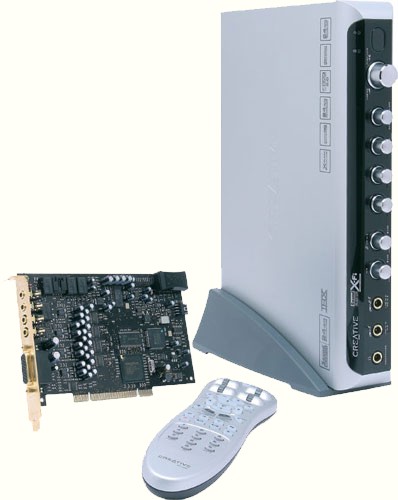Creative X-Fi: A New World of Sound
Introduction

We have been spending lots of time with the latest sound card from Creative, called the X-Fi. While it looks like an ordinary PCI sound card, the innards are completely new and improved and worth spending some time on. Here we give you plenty of the straight dope, based on our tests and living with various pre-production versions for over a year now. You might also want to review our two previous articles on the card that we published earlier this summer:
The Rise To Power
Creative's sound cards have undergone considerable development, starting with the days of the first Sound Blaster "PRO" card in 1991, which offered 8-bit sound. This was followed by the famous AWE 32 and Live!, and then the Audigy, which has been the standard for sound cards until now. But X-Fi represents an enormous leap forward in terms of power and capability for handling and processing digital audio. In the table below, the evolution can be clearly seen Compare Prices on X-Fi Sound Cards!
| Sound card | Raw Data Path MIPs | Typical Processor MIPs | Internal Audio Channels | Overall Audio Sample Rate & Effects Processing MIPS vs Live! | No. of Simultaneous Real-time Effects | No. of Transistors |
|---|---|---|---|---|---|---|
| Sound Blaster Pro | ?1 | 3+ | - | 0.0001x | - | 100K |
| AWE 32 (EMU8000) | 67 | 200+ | - | 0.2x | - | 500K |
| Live! (10k1) | 335 | 1,000+ | 16(to Effects Engine) | 1x | 1 | 2M |
| Audigy (10k2) | 424 | 1,250+ | 64(to Effects Engine) | 4x | 4 | 4.6M |
| Creative X-Fi | 10340 | 30,000+ | 4096(to all Processing Elements) | 67x | 8 | 51.1M |
We should stress the fact that Creative, unlike most of its competitors, has always included a true audio processor on its cards, as opposed to simply using a codec and putting the processing load on the CPU. That approach accounts for their superiority in games, where Creative avoids having to devote part of the available processing power to sound, but it also creates a few problems in other areas. The processors used in the Live! and Audigy cards operated natively at 48 kHz, creating some problems at 44.1 kHz and simply refusing to process higher sampling frequencies at all. With X-Fi, those problems are behind us, and operation is now possible at all usable sampling frequencies.
Stay On the Cutting Edge: Get the Tom's Hardware Newsletter
Get Tom's Hardware's best news and in-depth reviews, straight to your inbox.